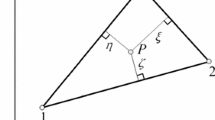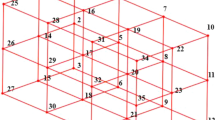Abstract
To obtain proper stresses , three new triangular elements are formulated in this study. First, a complementary energy functional is used within an element for the analysis of plane problems. In this energy manifestation, the Airy stress function will be applied as a functional variable. Then, some basic analytical solutions are assigned for the stress functions. These trial functions are matched with each element number of degrees of freedom. The result is a number of equations with anonymous constants. Subsequently, according to the principle of minimum complementary energy, the unknown constants can be expressed in terms of displacements. Finally, this system can be rewritten in terms of the nodal displacement. In this way, three new triangular elements are formulated. To validate the results, extensive numerical studies are performed. The findings clearly demonstrate accuracies of structural displacements as well as stresses.










Similar content being viewed by others
Abbreviations
- AT6:
-
Accurate triangular element
- t :
-
Thickness of the element
- U :
-
Displacement vector along element boundaries
- \( \mu \) :
-
Poisson’s ratio
- \( {D_{ij}} \) :
-
Elastic modulus
- \( l \) and m :
-
Direction cosines of the outer normal
- \( {{\varPi }}_C^* \) :
-
Complementary energy within the element
- \( \sigma \) :
-
The stress vector of the element
- C :
-
Elastic flexibility matrix
- \( \varphi \) :
-
Airy stress function
- \( {C_{ij}} \) :
-
Elastic compliances
- \( {u_i} \) :
-
Nodal displacements belong to x
- \( V_C^* \) :
-
Complementary energy along the element boundaries
- T :
-
Surface force vector on the element boundaries
- \( E \) :
-
Young’s modulus
- \( {q^e} \) :
-
Elemental nodal displacement vector
- x′ and y′:
-
Axes of material symmetry
- v i :
-
Nodal displacements belong to y
- \( N_i^0\left( {{\xi_1},{\xi_2}} \right) \) :
-
Shape function
References
Fu XR, Cen S, Li CF, Chen XM (2008) Analytical trial function method for development of new 8-node plane element based on the variational principle containing airy stress function. Eng Comput Int J Comput Aided Eng Softw 27(4):442–463
Stricklin JA, Ho WS, Richardson EQ, Haister WE (1977) ‘On isoparametric vs linear strain triangular elements’. Int J Numer Methods Eng 11:1041–1043
Lee NS, Bathe KJ (1993) Effects of element distortion on the performance of isoparametric elements. Int J Numer Methods Eng 36:3553–3576
Kikuchi F, Okabe M, Fujio H (1999) Modification of the 8-node serendipity element. Comput Methods Appl Mech Eng 179:91–109
Li LX, Kunimatsu S, Han XP, Xu SQ (2004) The analysis of interpolation precision of quadrilateral elements. Finite Elem Anal Design 41:91–108
Rajendran S, Liew KM (2003) ‘A novel unsymmetric 8-node plane element immune to mesh distortion under a quadratic displacement field’. Inte J Numer Methods Eng 58:1713–1748
Li CJ, Wang RH (2006) A new 8-node quadrilateral spline finite element. J Comput Appl Math 195:54–65
Long YQ, Xu Y (1994) Generalized conforming triangular membrane element with vertex rigid rotational freedom. Finite Elem Anal Design 17:259–271
Cen S, Chen XM, Fu XR (2007) Quadrilateral membrane element family formulated by the quadrilateral area coordinate method’. Comput Methods Appl Mech Eng 196(41–44):4337–4353
Soh AK, Long YQ, Cen S (2000) Development of eight-node quadrilateral membrane elements using the area coordinates method. Comput Mech 25(4):376–384
Cen S, Fu XR, Zhou MJ (2011) 8- and 12-node plane hybrid stress-function elements immune to severely distorted mesh containing elements with concave shapes. Comput Methods Appl Mech Eng 200:2321–2336
Cen S, Zhou MJ, Fu XR (2011) A 4-node hybrid stress-function (HS-F) plane element with drilling degrees of freedom less sensitive to severe mesh distortions. Comput Struct 89(5–6):517–528
Sergei N, Viacheslav K, Antti B, Niemi H (2016) Variational formulation and isogeometric analysis for fourth-order boundary value problems of gradient-elastic bar and plane strain/stress problems. Comput Methods Appl Mech Eng 308:182–211
Albocher U, Oberai AA, Barbone PE, Harari I (2009) Adjoint-weighted equation for inverse problems of incompressible plane-stress elasticity. Comput Methods Appl Mech Eng 198(30–32):2412–2420
Cen S, Fu XR, Zhou GH, Zhou MJ, Li CF (2011) Shape-free finite element method: the plane hybrid stress-function (HS-F) element method for anisotropic materials. Sci China Phys Mech Astron 54(4):653–665
Zhou P, Cen S (2015) A novel shape-free plane quadratic polygonal hybrid stress-function element. Math Probl Eng. https://doi.org/10.1155/2015/491325
Babaniyi OA, Oberai AA, Barbone PE (2017) Direct error in constitutive equation formulation for plane stress inverse elasticity problem. Comput Methods Appl Mech Eng 314:3–18
Cervera M, Chiumenti M, Capua DD (2012) Benchmarking on bifurcation and localization in J2 plasticity for plane stress and plane strain conditions. Computer Methods Appl Mech Eng Vol 241–244:206–224
Artioli E, Miranda ED, Lovadina C, Patruno L (2017) A stress/displacement virtual element method for plane elasticity problems. Comput Methods Appl Mech Eng 325:155–174
Rezaiee-Pajand M, Karkon M (2016) Geometrical nonlinear analysis of plane problems by corotational formulation. J Eng Mech 142(10):04016073
Madeo A, Zagari G, Casciaro R (2012) An isostatic quadrilateral membrane finite element with drilling rotations and no spurious modes. Finite Elem Anal Design 50:21–32
Madeo A, Casciaro R, Zagari G, Zinno R, Zucco G (2014) A mixed isostatic 16 dof quadrilateral membrane element with drilling rotations based on Airy stresses. Finite Elem Anal Design 89:52–66
Fosdick R, Schuler K (2003) Generalized airy stress functions. Meccanica 38:571–578
Zavelani Rossi A (1974) Finite element techniques in plane limit problems. Meccanica 9(4):312–324
Benedetti D, Maier G, Zavelani Rossi A (1972) A finite element approach to optimal design of plastic structures in plane stresses. Meccanica 7(1):37–38
Zienkiewicz OC, Taylor RL, Zhu JZ (2005) The finite element method: its basis and fundamental, 6th edn. Heinemann, Butterworth
Lee NS, Bathe KJ (1993) Effects of element distortion on the performance of isoparametric elements. Int J Numer Methods Eng 36:3553–3576
Taylor RL, Beresford PJ, Wilson EL (1976) A non-conforming element for stress analysis. Int J Numer Methods Eng 10:1211–1219
Ibrahimbegovic A, Wilson EL (1991) A modified method of incompatible modes. Commun Appl Numer Methods 7:187–194
Simo JC, Rifai MS (1990) A class of mixed assumed strain methods and the method of incompatible modes. Int J Numer Methods Eng 29:1595–1638
Hughes TJR (1980) Generalization of selective integration procedures to anisotropic and nonlinear media. Int J Numer Methods Eng 16:1413–1418
Chen J, Li CJ, Chen WJ (2010) A family of spline finite elements. Comput Struct 88:718–727
Ooi ET, Rajendran S, Yeo JH (2004) A 20-node hexahedron element with enhanced distortion tolerance. Int J Numer Methods Eng 2004(60):2501–2530
Long ZF, Li JX, Cen S (1999) Some basic formulae for area coordinates used in quadrilateral elements. Commun Numer Methods Eng 15:841–852
Chen XM, Cen S, Long YQ (2003) Membrane elements insensitive to distortion using the quadrilateral area coordinate method. Comput Struct 82:35–54
Chen XM, Cen S, Fu XR (2008) A new quadrilateral area coordinate method (QACM-II) for developing quadrilateral finite element models. Int J Numer Methods Eng 73:1911–1941
Zhang X, Liu XH, Song KZ (2001) Least-squares collocation meshless method. Int J Numer Methods Eng 51:1089–1100
Zhang JM, Yao ZH, Li H (2002) A hybrid boundary node method. Int J Numer Methods Eng 53:751–763
Taylor RL, Beresford PJ, Wilson EL (1976) A non-conforming element for stress analysis. Int J Numer Methods Eng 10:1211–1219
MacNeal RH, Harder RL (1985) A proposed standard set of problems to test finite element accuracy. Finite Elem Anal Des 1(1):3–20
Pian THH, Sumihara K (1984) Rational approach for assumed stress finite elements. Int J Numer Methods Eng 20:1685–1695
Allman DJ (1988) A quadrilateral finite element including vertex rotations for plane elasticity analysis. Int J Numer Methods Eng. 26:717–730
MacNeal RH, Harder RL (1988) A refined four-nodded membrane element with rotational degrees of freedom. Comput Struct 28:75–84
Choi N, Choo YS, Lee BC (2006) A hybrid Trefftz plane elasticity element with drilling degrees of freedom. Comput Methods Appl Mech Eng 195:4095–4105
Long YQ, Xu Y (1994) Generalized conforming quadrilateral membrane element with vertex rigid rotational freedom. Comput Struct 52(4):749–755
Pimpinelli G (2004) An assumed strain quadrilateral element with drilling degrees of freedom. Finite Elem Anal Des 41:267–283
Zhang H, Kuang JS (2008) Eight-node membrane element with drilling degrees of freedom for analysis of in-plane stiffness of thick floor plates. Int J Numer Methods Eng 76:2117–2136
Funding
This study was not funded by any company.
Author information
Authors and Affiliations
Corresponding author
Ethics declarations
Conflict of interest
The authors declare that they have no conflict of interest.
Additional information
Publisher's Note
Springer Nature remains neutral with regard to jurisdictional claims in published maps and institutional affiliations.
Rights and permissions
About this article
Cite this article
Rezaiee-Pajand, M., Karimipour, A. Three stress-based triangular elements. Engineering with Computers 36, 1325–1345 (2020). https://doi.org/10.1007/s00366-019-00765-6
Received:
Accepted:
Published:
Issue Date:
DOI: https://doi.org/10.1007/s00366-019-00765-6




